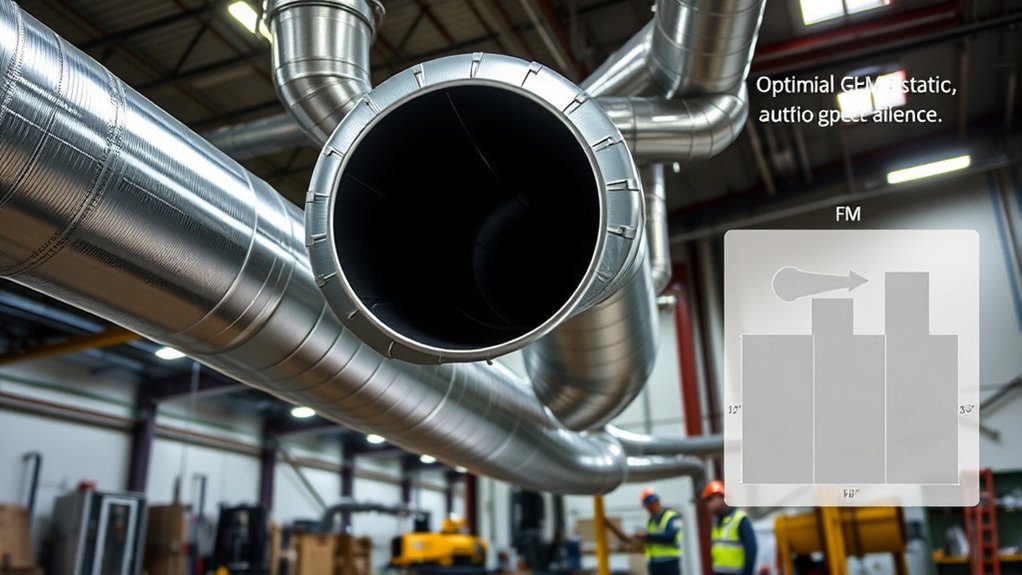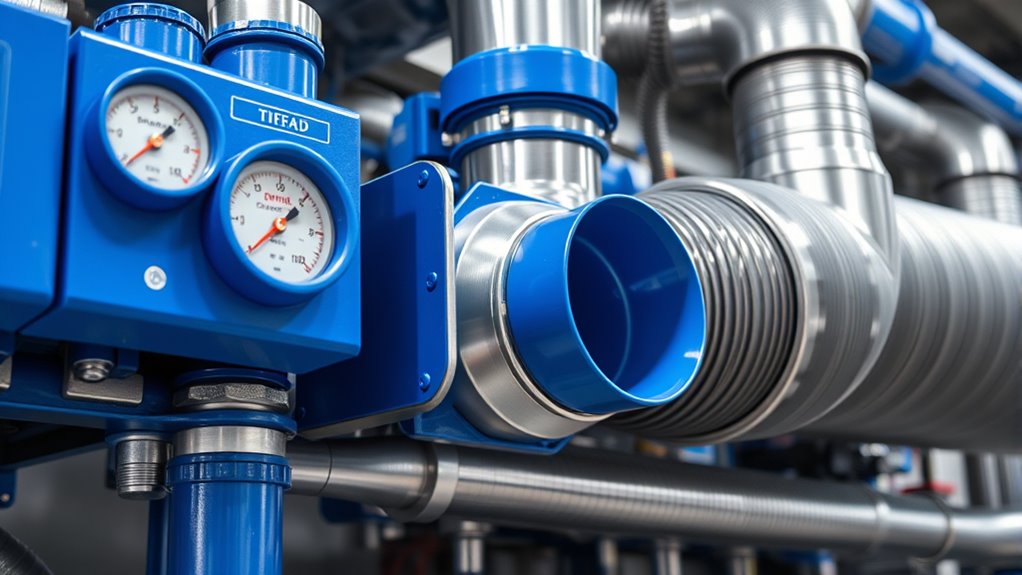When choosing a dust collection system, focus on matching CFM to your tool’s airflow needs to guarantee efficient dust capture. Keep static pressure low to maintain performance without overloading your fan, and select duct sizes that support proper airflow without excessive resistance. Properly balancing these factors creates a safe, effective system. To optimize your setup and learn more about achieving ideal airflow, static pressure, and duct sizing, continue exploring the key principles involved.
Key Takeaways
- Ensure the CFM matches your dust load to maintain effective airflow and proper dust capture.
- Calculate static pressure to select a system that can handle duct resistance without performance loss.
- Size ducts appropriately to balance airflow capacity and minimize static pressure for efficient dust transport.
- Maintain system balance by adjusting CFM, static pressure, and duct size for optimal filtration and workspace cleanliness.
- Consider future expansion and dust volume to select scalable CFM and ducting that support long-term system performance.

Effective dust collection relies on understanding three key factors: CFM (cubic feet per minute), static pressure, and duct sizing. These elements determine how well your system captures and transports dust, ensuring a cleaner and safer workspace. When selecting a dust collector, pay close attention to filter efficiency, as it directly impacts the system’s ability to trap fine particles. High filter efficiency means fewer airborne dust particles escape back into the environment, which is essential for maintaining air quality and protecting your health. Look for filters rated at MERV 11 or higher, especially if you’re working with fine dust or hazardous materials. Additionally, filter quality influences noise reduction; high-quality filters tend to operate more quietly because they create less airflow turbulence and resist airflow restrictions better. This means you can enjoy a quieter workspace without sacrificing dust collection performance.
Choosing the right filter isn’t just about efficiency; it’s also about longevity and maintenance. Efficient filters last longer and require less frequent replacements, saving you money and reducing system downtime. When you select a filter that balances high efficiency with durability, you ensure your dust collection system runs smoothly over time. Noise reduction is another benefit tied closely to filter choice and system design. A well-designed filter system reduces noise levels, making your workspace more comfortable. Properly sealed filters prevent leaks and airflow disturbances that cause loud whistling or humming sounds, which can be disruptive during long work sessions.
The key to enhancing filter efficiency and noise reduction lies in selecting filters appropriate for your specific dust type and volume. Avoid filters that are too fine for your application, as they can cause increased static pressure and noise, or too coarse, which can compromise dust capture. Properly sealing and replacing filters at recommended intervals also helps minimize noise and maintain optimal airflow. Remember, a system that operates quietly and efficiently is more likely to be used consistently, ensuring ongoing protection against dust hazards.
Frequently Asked Questions
How Often Should I Replace or Clean My Dust Collection Filters?
You should clean your dust collection filters regularly, ideally once a month, and replace them when they show signs of wear or reduced airflow. Follow your filter’s maintenance and replacement schedule, as manufacturers often recommend specific intervals. Keep an eye out for increased static pressure or decreased performance, which indicate it’s time for a replacement. Proper filter maintenance guarantees maximum dust collection and prolongs the life of your system.
Can I Upgrade My Existing Dust Collection System for Better Performance?
Yes, you can upgrade your existing dust collection system for better performance. Focus on system upgrades like installing higher CFM units or increasing duct size to improve airflow. Additionally, prioritize filter maintenance by replacing or cleaning filters regularly to guarantee peak performance. Upgrading components and maintaining filters together help enhance efficiency, reduce static pressure, and keep your workspace cleaner and safer.
What Safety Precautions Are Necessary When Installing Dust Collection Ductwork?
Think of installing ductwork like building a fortress—you need to be protected. Always wear personal protective equipment like gloves, goggles, and a dust mask to shield yourself from debris and dust. Make certain electrical safety by turning off power before work, checking for proper grounding, and avoiding exposed wiring. This way, you prevent accidents and keep your workspace safe during installation, making your dust collection system both effective and secure.
How Does Ambient Temperature Affect Dust Collection Efficiency?
Ambient temperature impacts dust collection efficiency by influencing dust filtration and airflow. When temperatures are too high, dust particles can become more airborne, reducing filtration effectiveness and potentially clogging filters faster. Conversely, colder temperatures may cause moisture to condense, leading to clogs and reduced airflow. Maintaining a stable ambient temperature helps guarantee consistent dust collection performance, keeping filters clean and airflow optimized for safer, more efficient dust removal.
Are There Eco-Friendly or Energy-Saving Dust Collection Options Available?
Imagine your dust collection system as a green guardian—there are eco-friendly options that protect both your workspace and the planet. You can opt for energy-efficient systems that sip power instead of gulping it, reducing your carbon footprint. Look for models with low energy consumption, eco-friendly filters, and sustainable materials. These choices help you cut costs, save energy, and support a healthier environment, all while keeping your workspace clean.
Conclusion
Remember, selecting the right dust collection system gently guides your workspace toward smoother operation. By understanding CFM, static pressure, and duct sizing, you help create an environment where everything flows seamlessly. When you pay attention to these details, you’re carefully steering your setup toward efficiency and safety. Trust your instincts and these principles—they’ll help ensure your workshop runs quietly and effortlessly, keeping dust at bay without a fuss.









